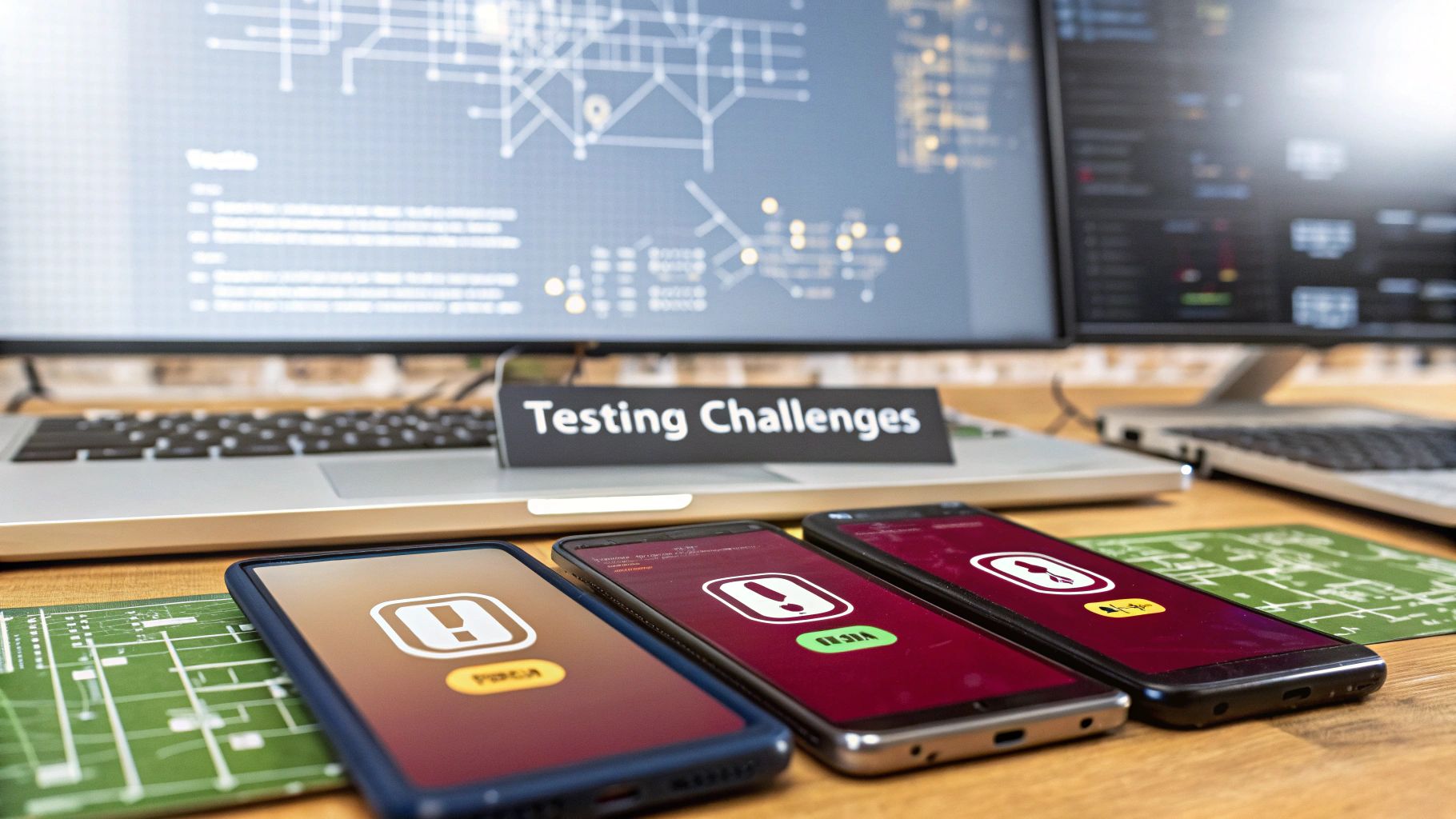The Ever-Evolving Landscape of Mobile App Testing
Mobile app testing is critical for delivering high-quality apps, but presents numerous challenges. This listicle identifies seven key mobile app testing challenges facing developers, QA, and product managers in 2025. Understanding these hurdles is crucial for successful app development and launch. This article provides actionable strategies to overcome difficulties related to device fragmentation, network variability, test automation, performance, security, usability, and CI/CD integration, ultimately leading to better app quality and user satisfaction. You’ll learn how to address these mobile app testing challenges and deliver exceptional user experiences.
1. Device Fragmentation
One of the most significant mobile app testing challenges is device fragmentation. This refers to the immense variety of devices, screen sizes, resolutions, operating systems, and OS versions available in the mobile market. Unlike desktop applications, which operate in relatively homogeneous environments, mobile apps must function flawlessly across thousands of different device configurations. This creates an exponential number of potential test scenarios, significantly increasing the complexity of mobile app testing. This challenge is particularly acute for React Native developers striving for cross-platform compatibility, DevOps engineers managing release pipelines, and QA teams ensuring a consistent user experience.
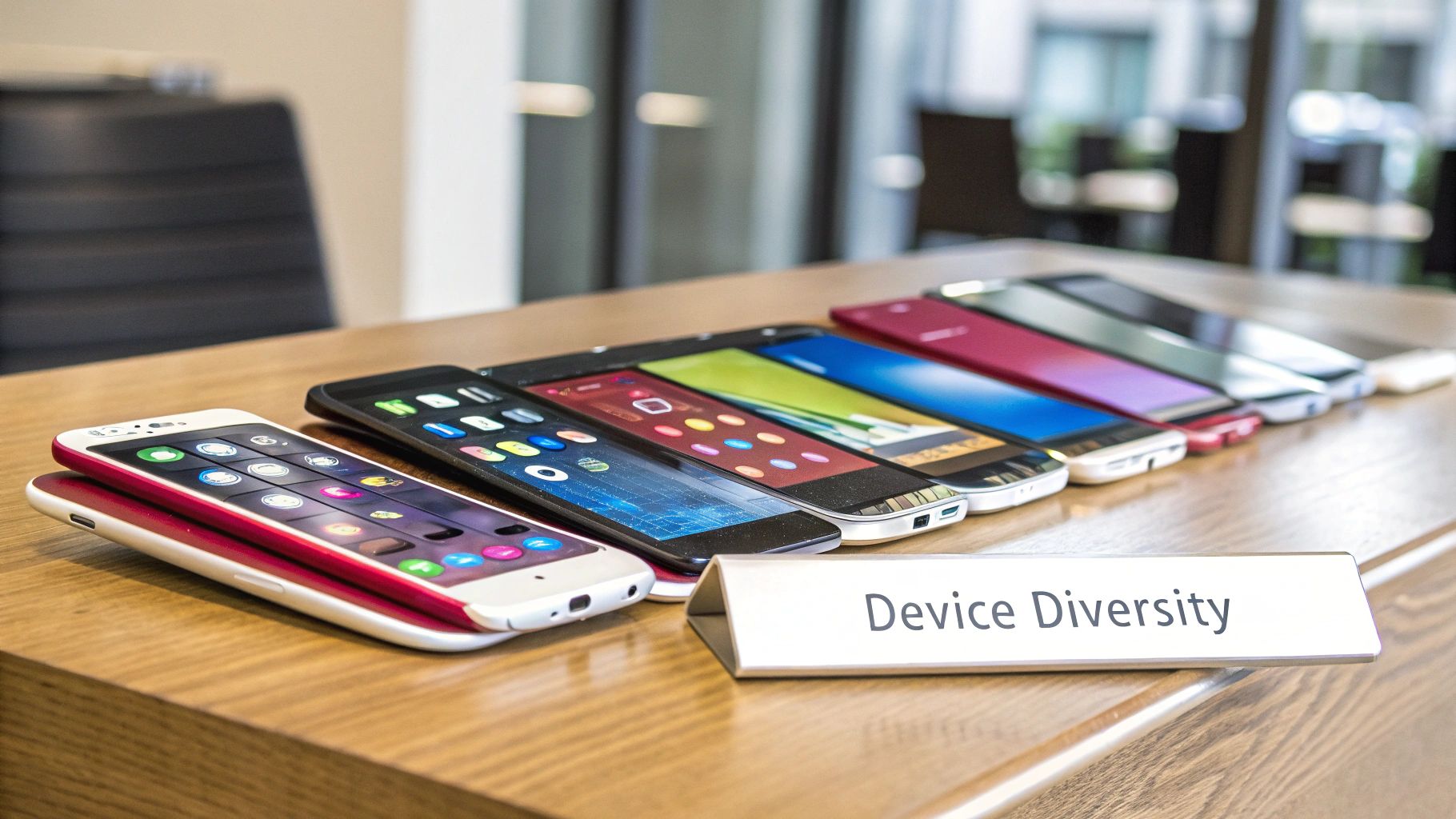
Device fragmentation encompasses several key aspects: testing across various manufacturers (Samsung, Apple, Google, etc.), accommodating diverse screen sizes and resolutions, ensuring compatibility with different OS versions (including various Android flavors and iOS iterations), and accounting for differences in hardware capabilities like sensors, cameras, and processing power. For security-conscious enterprise organizations and product managers, addressing device fragmentation is crucial for protecting sensitive data and gathering accurate real-time insights across the user base.
Features:
- Multi-Manufacturer Testing: Covers devices from various manufacturers, ensuring compatibility across brands.
- Screen Size and Resolution Adaptation: Accounts for different screen dimensions and pixel densities.
- OS Version Compatibility: Addresses compatibility with various operating system versions and variants.
- Hardware Capabilities: Considers variations in processing power, sensors (GPS, accelerometer), camera specifications, and other hardware features.
Pros:
- Expanded Market Reach: Thorough device testing maximizes the potential audience for your app.
- Edge Case Identification: Uncovers potential issues specific to certain device configurations.
- Enhanced User Experience: Ensures a consistent and positive user experience across the device ecosystem.
Cons:
- Exhaustive Testing Impractical: Testing every possible device/OS combination is virtually impossible.
- Resource Intensive: Requires significant time, resources, and expertise.
- Test Environment Limitations: Simulated environments may not perfectly replicate real-world device performance.
- Costly Infrastructure: Maintaining a physical device lab or utilizing cloud-based testing services can be expensive.
Examples of Successful Implementation:
- BrowserStack: Offers testing on 3000+ real devices and browsers.
- Google Firebase Test Lab: Provides virtual and physical device testing for Android apps.
- AWS Device Farm: Enables testing on a wide range of physical devices and provides detailed test logs.
Tips for Addressing Device Fragmentation:
- Prioritize Based on Analytics: Use analytics data to identify the most common devices among your target audience.
- Leverage Cloud Testing Services: Utilize device farms or cloud-based testing platforms like BrowserStack, Firebase Test Lab, or AWS Device Farm. This is a more cost-effective approach than maintaining a physical device lab.
- Develop a Device Matrix: Create a prioritized testing matrix based on device popularity and strategic importance.
- Embrace Responsive Design Principles: Implement responsive design practices to minimize device-specific UI/UX issues.
Why Device Fragmentation Matters:
Device fragmentation deserves a top spot on this list because it presents a fundamental challenge to mobile app development. Ignoring it can lead to a poor user experience, negative reviews, and ultimately, app failure. Addressing device fragmentation effectively is crucial for reaching a wider audience, ensuring app stability, and maximizing the return on investment. The rise of the Android ecosystem with its open manufacturer approach and the continued use of multiple generations of Apple devices have further amplified this challenge, making it a critical consideration for any mobile app development project. Major testing platforms like Sauce Labs, LambdaTest, and Perfecto further highlight the industry’s recognition of device fragmentation as a key challenge.
2. Network Conditions Variability
Network conditions variability is a significant mobile app testing challenge. Unlike desktop applications that typically operate on stable network connections, mobile apps function in diverse environments ranging from robust Wi-Fi networks to intermittent 3G/4G connections and even offline scenarios. Testing how an app performs across this spectrum of connectivity is critical for ensuring a positive user experience but presents considerable challenges due to the difficulty of replicating real-world network instability within a testing environment. This variability in network quality, speed, and availability significantly impacts app performance, making it a key focus area for mobile app testing.
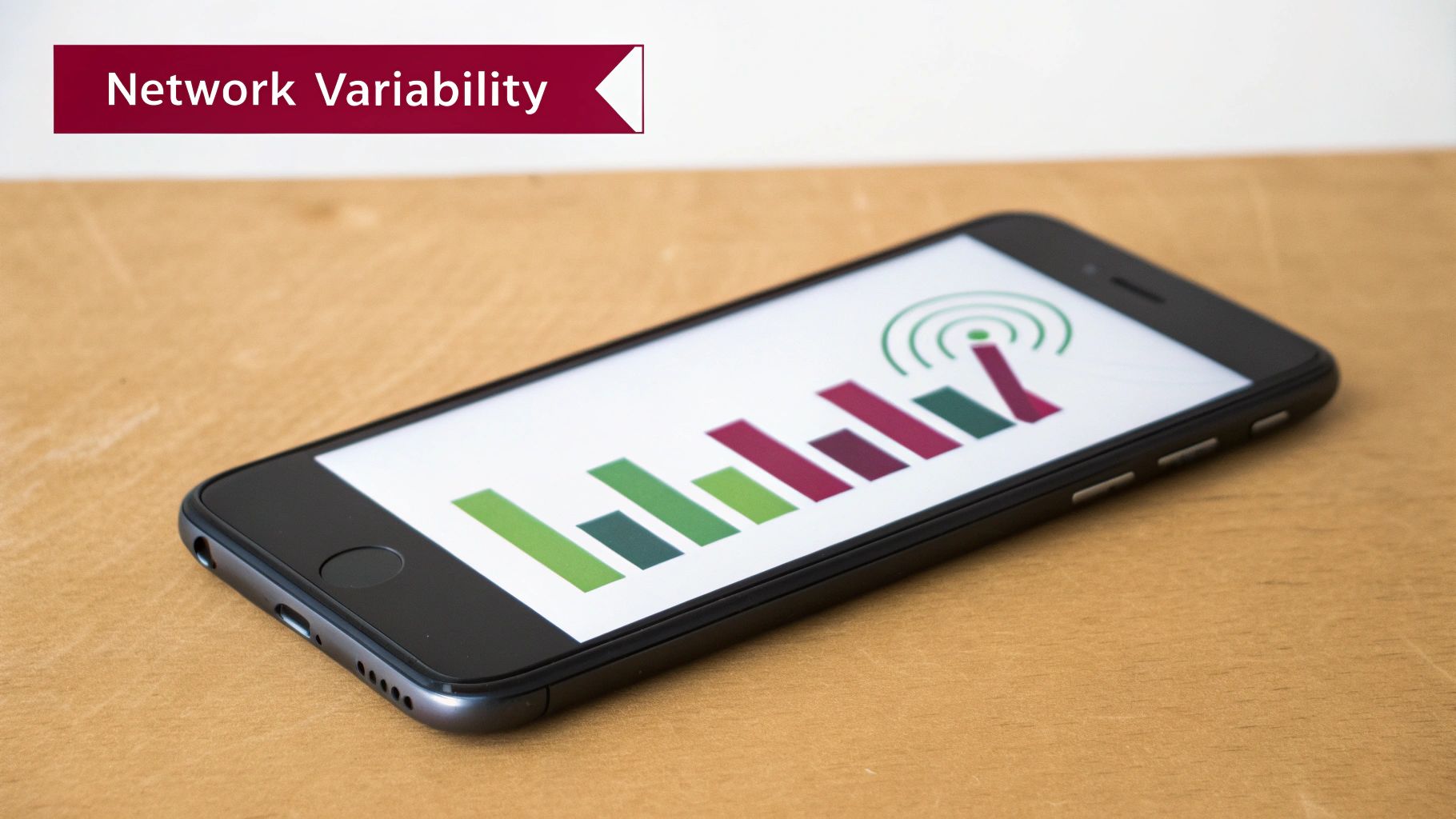
Testing for network conditions variability involves simulating various connectivity scenarios. This includes testing across different connection types (Wi-Fi, 5G, 4G, 3G, Edge), simulating varying signal strengths and packet loss, and evaluating how the app handles connection transitions (e.g., switching from Wi-Fi to cellular data). A crucial aspect is also testing offline capabilities and data synchronization mechanisms, ensuring the app functions gracefully even without internet access.
Examples of Successful Implementation:
- Facebook Lite: Developed specifically for low-bandwidth environments, Facebook Lite demonstrates a successful approach to optimizing for varying network conditions. Its streamlined design and data usage efficiency make it usable even on slow connections.
- Google Maps: The offline functionality in Google Maps allows users to download maps for specific areas, enabling navigation even without an internet connection. This feature has been rigorously tested across various network states to ensure seamless transitions and data integrity.
- Netflix: The adaptive streaming technology employed by Netflix dynamically adjusts the video quality based on the available network bandwidth, ensuring a smooth viewing experience even with fluctuating network conditions.
Tips for Effective Network Conditions Testing:
- Utilize Network Throttling Tools: Tools like Charles Proxy, Network Link Conditioner (built into macOS and iOS), and the network throttling capabilities in Chrome DevTools allow developers and testers to simulate different network speeds and latency.
- Automate Key Network Scenarios: Automate tests for critical network scenarios like offline mode, reconnection events, and switching between connection types to ensure consistent and repeatable testing.
- Test on Real Devices and Networks: While simulation tools are valuable, testing on real devices across different network carriers and locations provides the most accurate representation of real-world performance.
- Integrate with CI/CD: Incorporate network condition testing into your Continuous Integration and Continuous Delivery pipelines to catch performance regressions early in the development cycle.
- Connection-Independent Architecture: Design your app with a “connection-independent” mindset, prioritizing local data storage and synchronization mechanisms to enable offline functionality and graceful handling of network interruptions.
Pros and Cons of Network Conditions Testing:
Pros:
- Enhanced App Resilience: Testing ensures the app can withstand real-world network fluctuations, providing a consistent user experience.
- Performance Bottleneck Identification: Testing reveals performance bottlenecks and excessive data usage, allowing for optimization.
- Improved User Experience: By addressing network variability, you can create a more reliable and user-friendly app, particularly in challenging connectivity environments.
Cons:
- Reproducibility Challenges: Consistently reproducing specific network conditions can be difficult, especially intermittent issues.
- Time-Consuming: Thoroughly testing all possible network scenarios can be time-intensive.
- Simulation Limitations: Network simulation tools may not perfectly replicate real-world network behavior.
- International Network Variations: Different network infrastructures and standards in various countries add complexity to testing.
Why This Matters:
Network conditions variability directly impacts user experience and app stability. For React Native developers, DevOps engineers, QA teams, and product managers, understanding and addressing these challenges is crucial for delivering a high-quality product. Security-conscious organizations also benefit from rigorous network testing, as vulnerabilities can be exposed under specific network conditions. By proactively addressing network variability, development teams can improve app resilience, enhance user satisfaction, and minimize potential security risks.
3. Test Automation Challenges
Automating tests is crucial for efficient mobile app testing, allowing for faster release cycles and more robust software. However, unlike web or desktop applications, mobile app test automation presents a unique set of hurdles. These challenges arise from the diversity of mobile platforms, rapid OS updates, varying screen sizes, and the complexity of simulating real user interactions. This is why understanding these challenges is crucial for React Native developers, DevOps engineers, QA teams, security-focused organizations, and product managers alike.
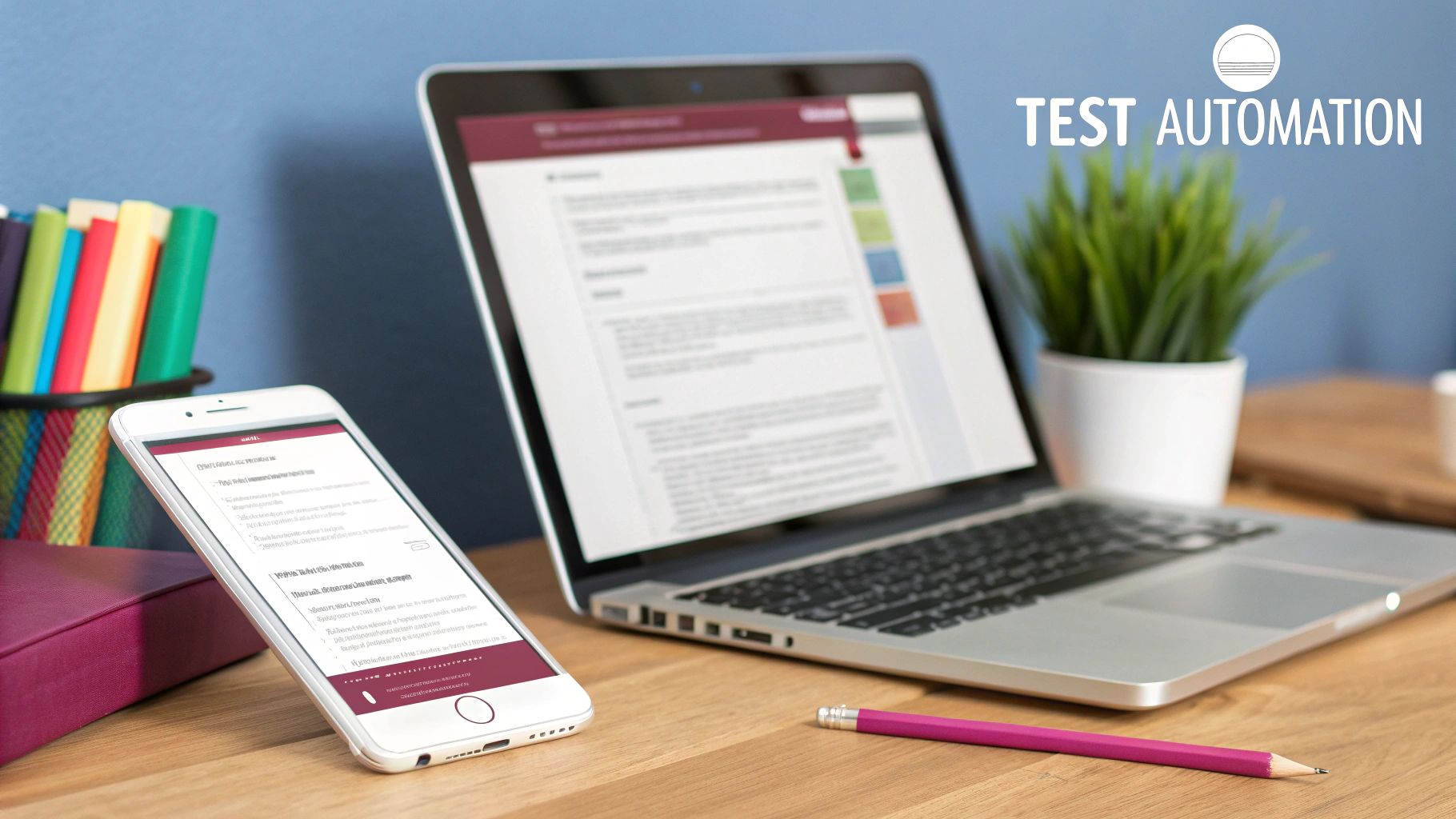
Mobile test automation needs to navigate platform-specific frameworks (like XCUITest for iOS and Espresso for Android), handle UI changes between OS versions, and accurately simulate complex user interactions such as gestures (swipes, pinches) and biometric inputs (fingerprint and face recognition). Further complicating matters are the differences between testing native and hybrid apps. Native apps, built specifically for a platform, often require separate test scripts for iOS and Android. Hybrid apps, built with technologies like React Native, offer a degree of cross-platform compatibility but still require careful attention to platform-specific UI elements and behaviors.
One of the major challenges lies in object recognition and UI element identification. Dynamic content, animations, and variations in screen sizes can make it difficult for automated tests to reliably locate and interact with UI elements. This can lead to flaky tests that fail intermittently, requiring significant maintenance and debugging effort. Another challenge comes from simulating real-world scenarios, including network conditions, different locations, and background processes. Achieving accurate and comprehensive test coverage necessitates tackling these complexities.
Features to consider when tackling mobile test automation:
- Cross-platform test automation complexity: Choosing frameworks and strategies that work seamlessly across multiple platforms.
- Native vs. hybrid app testing approaches: Tailoring the testing strategy based on the app’s architecture.
- Handling of device-specific gestures and inputs: Implementing robust methods for simulating diverse user interactions.
- Object recognition and UI element identification challenges: Employing reliable techniques to locate and interact with UI elements despite dynamic content and varying screen sizes.
Pros of Mobile Test Automation:
- Significantly reduces regression testing time: Automating repetitive tests frees up QA resources.
- Enables continuous integration/continuous delivery (CI/CD) pipelines: Automated tests are essential for CI/CD workflows.
- Provides consistent test coverage across releases: Ensures a consistent level of quality throughout the app’s lifecycle.
- Allows for testing at scale across multiple device configurations: Enables parallel testing across a wide range of devices and OS versions.
Cons of Mobile Test Automation:
- High initial setup cost and learning curve: Implementing automation requires investment in tools, infrastructure, and training.
- Test flakiness and maintenance overhead: Automated tests can be brittle and require ongoing maintenance.
- Framework limitations with new platform features: Test frameworks might not always support the latest OS features immediately.
- Challenges in simulating complex user interactions: Accurately replicating real-world usage scenarios can be difficult.
- Limited access to low-level device functions: Accessing certain device features might be restricted by the test framework.
Companies like Uber, Facebook, and Airbnb have invested heavily in mobile test automation. Uber reportedly runs over 30,000 automated tests daily, while Facebook uses automated screenshot testing to ensure visual consistency across app versions. Airbnb even developed and open-sourced their own tool, Lona, for consistent UI testing across platforms. These examples showcase the value and importance of tackling the challenges of mobile test automation.
Tips for Successful Mobile Test Automation:
- Choose the right automation framework: Appium is a popular choice for cross-platform testing. For native apps, consider XCUITest for iOS and Espresso for Android.
- Implement a robust object identification strategy: Use unique and stable identifiers to locate UI elements.
- Design tests for stability across OS versions: Account for potential UI changes between OS versions.
- Use the Page Object Model (POM) pattern: This design pattern improves code maintainability and reduces redundancy.
- Combine automated and manual testing approaches strategically: Automation should complement, not replace, manual testing efforts.
Learn more about Test Automation Challenges
This area deserves a prominent place in any discussion about mobile app testing challenges because effective automation is critical for delivering high-quality mobile apps quickly and efficiently. Addressing these challenges head-on is essential for any organization seeking to build and maintain successful mobile applications.
4. Performance and Battery Testing
Performance and battery testing are crucial aspects of mobile app testing, directly impacting user experience and app store rankings. Mobile applications must deliver high performance while conserving battery life—a challenging balance to achieve and test effectively. This involves analyzing various factors like CPU usage, memory management, startup time, responsiveness, and, of course, battery drain. These tests go beyond simply checking if the app functions correctly; they delve into how efficiently the app performs its functions. This is a critical mobile app testing challenge because poor performance can lead to negative reviews, uninstalls, and ultimately, the failure of your app.
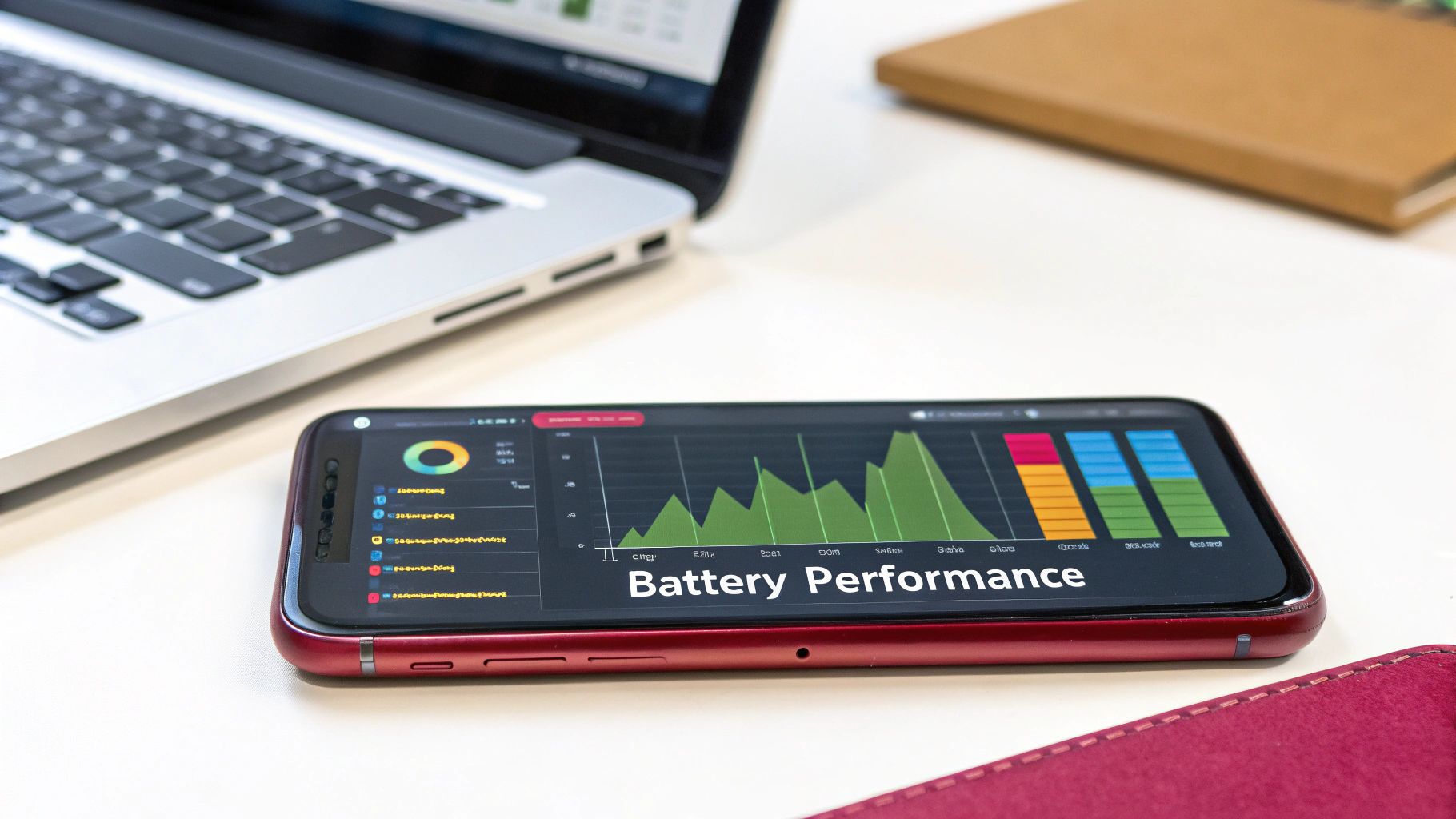
Performance and battery testing encompasses a range of features, including CPU and memory utilization monitoring, battery consumption measurement, app startup time and screen transition metrics, resource leak detection, and background processing efficiency. These metrics provide valuable insights into the app’s behavior under various conditions. For instance, resource leak detection helps identify areas where the app might be holding onto memory unnecessarily, eventually leading to crashes or slowdowns. Similarly, analyzing background processing efficiency ensures that background tasks don’t excessively drain the battery.
Pros of Performance and Battery Testing:
- Identifies resource-intensive operations before release: Catching performance bottlenecks early allows developers to address them before they impact users.
- Improves user satisfaction and app store ratings: Smooth, responsive apps with good battery life lead to happier users and better reviews.
- Reduces uninstall rates due to performance issues: Addressing performance concerns minimizes user frustration and prevents uninstalls.
- Helps optimize for lower-end devices: Ensures the app runs smoothly even on less powerful devices, expanding your user base.
Cons of Performance and Battery Testing:
- Difficult to consistently measure across different devices: Device fragmentation in the Android ecosystem makes it challenging to obtain consistent results.
- Performance metrics can vary between test runs: External factors can influence performance, making it hard to reproduce identical results.
- Battery testing is time-consuming and hard to automate fully: Battery tests often require extended periods and specific scenarios, hindering full automation.
- Requires specialized tools and expertise: Effectively conducting performance and battery testing requires specialized tools and skilled testers.
Examples of Successful Implementation:
- Pokemon GO: Significantly reduced battery consumption by 15% through aggressive performance testing and optimization.
- WhatsApp: Focus on performance testing enables the app to function reliably even on entry-level devices with limited resources.
- Spotify: Optimized background audio playback to strike a balance between audio quality and battery life.
Actionable Tips for Developers and Testers:
- Use profiling tools: Leverage Android Profiler and Xcode Instruments for detailed performance analysis and identifying bottlenecks.
- Establish performance budgets: Define acceptable performance thresholds for key user journeys to guide optimization efforts.
- Automate performance testing: Integrate automated performance tests into CI/CD pipelines to catch regressions early.
- Test in different battery states and power modes: Simulate real-world scenarios by testing in various battery conditions and power saving modes.
- Conduct comparative testing: Analyze your app’s performance against competitors to identify areas for improvement.
- Utilize real-world monitoring tools: Integrate tools like Firebase Performance Monitoring or similar platforms to collect performance data from real users.
Key Players and Influences:
Google’s Android Vitals initiative and Apple’s App Store guidelines have emphasized the importance of app performance. Tools like New Relic and AppDynamics provide robust mobile performance monitoring capabilities. Facebook has also contributed to the field with the development of performance testing tools like Fishhook and Infer.
Performance and battery testing is an undeniable challenge in mobile app development, but it’s also essential for success. By addressing this challenge head-on and implementing the tips provided, developers and QA teams can deliver high-performing, battery-efficient apps that delight users and thrive in the competitive mobile landscape. This is especially crucial for our target audience of React Native developers, DevOps and release engineers, QA and beta testing teams, security-conscious enterprise organizations, and product managers seeking real-time insights. They all benefit from understanding and prioritizing performance and battery testing throughout the app development lifecycle.
5. Security Testing Complexity
Security testing complexity represents a significant challenge in mobile app testing, demanding its place on this list due to the sensitive nature of data handled by modern applications. Mobile apps frequently process personal information, financial transactions, and access device features, making them prime targets for malicious actors. This necessitates robust security testing, but the mobile environment introduces complexities that make this process particularly demanding for React Native app developers, DevOps and release engineers, QA and beta testing teams, security-conscious enterprise organizations, and product managers seeking real-time insights.
Mobile security testing isn’t simply about checking for bugs; it’s about verifying the integrity of the entire app ecosystem. It involves scrutinizing how data is stored, transmitted, and accessed, while also ensuring robust authentication mechanisms and addressing platform-specific vulnerabilities. This all takes place within the constraints of mobile operating systems (like iOS and Android) and their respective security models. Learn more about Security Testing Complexity for a deeper dive into various aspects of mobile app security.
Key features of robust mobile app security testing include:
- Data encryption implementation and validation: Ensuring sensitive data is encrypted both in transit and at rest.
- Secure authentication mechanism testing: Verifying the strength and reliability of user authentication, including biometric and multi-factor authentication.
- API security validation: Testing the security of APIs used by the app to communicate with backend servers.
- Secure data storage verification: Confirming data is stored securely on the device and in the cloud, protected from unauthorized access.
- Permission and privacy compliance testing: Making sure the app adheres to privacy regulations (like GDPR and CCPA) and only requests necessary permissions.
- Code obfuscation effectiveness assessment: Evaluating the resilience of the code against reverse engineering attempts.
Pros of thorough security testing:
- Protects user data and company reputation: Preventing data breaches safeguards user trust and avoids reputational damage.
- Prevents costly security breaches: Proactive security testing can identify vulnerabilities before they are exploited, saving significant financial losses.
- Ensures compliance with regulations like GDPR, CCPA: Meeting regulatory requirements avoids legal penalties and fosters user confidence.
- Meets app store security requirements: Robust security testing ensures the app meets app store guidelines, facilitating smooth publication.
Cons of security testing:
- Requires specialized security expertise: Effective security testing often demands skilled security professionals with experience in mobile environments.
- Security testing tools have limitations on mobile platforms: Mobile security testing tools may not cover all potential vulnerabilities or integrate seamlessly with all development workflows.
- Difficult to automate comprehensively: While some aspects can be automated, manual penetration testing is often necessary to uncover more complex vulnerabilities.
- Security landscape constantly evolves, requiring ongoing testing: New threats emerge continuously, making security testing an ongoing process, not a one-time event.
Examples of successful security testing implementation:
- Banking apps like Chase Mobile: Implement biometric authentication and undergo rigorous security testing to protect user financial data.
- Signal messenger: Utilizes end-to-end encryption and undergoes continuous security validation to guarantee message privacy.
- Mobile payment platforms like Google Pay: Conduct extensive penetration testing to ensure the security of financial transactions.
Actionable tips for mobile app security testing:
- Follow OWASP Mobile Security Testing Guide (MSTG) standards: Adhere to industry-recognized best practices for mobile security testing.
- Implement both static and dynamic application security testing (SAST/DAST): Combine both methods for comprehensive vulnerability detection.
- Use dedicated mobile security testing tools like MobSF: Leverage specialized tools for mobile-specific security analysis.
- Conduct regular penetration testing with mobile specialists: Engage expert penetration testers to identify and exploit potential vulnerabilities.
- Apply security testing throughout the development lifecycle, not just pre-release: Integrate security testing into every stage of development to catch vulnerabilities early.
- Test for insecure data storage, network communication, and authentication: Focus on these critical areas frequently targeted by attackers.
Organizations like the OWASP Mobile Security Project, NowSecure, Synopsys, HackerOne, and Bugcrowd have popularized and advanced mobile security testing methodologies and tools, helping developers build more secure applications. By prioritizing security testing and implementing these tips, you can significantly reduce the risk of security breaches and protect your users’ valuable data. This proactive approach is essential for building trust, maintaining a positive reputation, and ensuring the long-term success of your mobile app in today’s challenging security landscape.
6. Usability and User Experience (UX) Testing: A Critical Mobile App Testing Challenge
Usability and User Experience (UX) testing is a crucial aspect of mobile app testing that focuses on evaluating how easy and enjoyable an app is to use. It goes beyond simply verifying functionality and delves into the subjective realm of user perception, encompassing elements like the app’s flow, intuitiveness, and the emotional response it evokes. This makes it one of the most significant mobile app testing challenges, particularly given the personal nature of mobile devices and the diverse contexts in which they are used. Users expect intuitive and seamless experiences, and failing to meet these expectations can lead to app abandonment. This is why UX testing deserves a prominent place on this list of mobile app testing challenges. Learn more about Usability and User Experience Testing
Unlike functional testing, which verifies that features work as intended, UX testing assesses the quality of the user’s interaction. This involves evaluating aspects like:
- Touch interaction and gesture testing: Ensuring responsiveness and intuitiveness of touch controls and gestures.
- Localization and accessibility validation: Confirming the app is usable and accessible across different languages and for users with disabilities.
- Visual design consistency across devices: Maintaining a cohesive visual experience across various screen sizes and resolutions.
- One-handed operation assessment: Considering the usability of the app for users operating it with one hand.
- Context-specific usage testing: Evaluating the app’s performance and usability in real-world scenarios, such as in motion, with varying lighting conditions, and with different network connectivity.
The benefits of thorough UX testing are numerous:
- Pros: Directly impacts user satisfaction and retention, reduces support costs by preventing usability issues, improves app store ratings and organic growth, identifies issues functional testing might miss.
However, UX testing also presents its own set of challenges:
- Cons: Subjective nature makes automation difficult, resource-intensive to conduct proper UX studies, cultural differences affect usability perceptions, results can be difficult to quantify.
Successful implementation of UX testing can be seen in companies like Duolingo, Uber, and Instagram. Duolingo utilizes extensive A/B testing of UX elements to optimize engagement, while Uber simplifies UX testing across global markets with varying user expectations. Instagram tests interface changes with limited user groups before full release, gathering valuable feedback before widespread deployment.
For React Native app developers, DevOps and release engineers, QA and beta testing teams, security-conscious enterprise organizations, and product managers seeking real-time insights, understanding the nuances of UX testing is critical. Here are some actionable tips for conducting effective UX testing:
- Combine analytics tools with qualitative user feedback: Use analytics to identify areas of friction and supplement this data with direct user feedback to understand the “why” behind the numbers.
- Implement remote usability testing with tools like UserTesting or Lookback: These tools allow you to observe users interacting with your app in their natural environment.
- Test with diverse user groups representing your target audience: Ensure your testing sample reflects the demographics and tech savviness of your intended users.
- Use screen recording and heat maps to analyze interaction patterns: Visualize user behavior to identify pain points and areas for improvement.
- Test in realistic environments (e.g., outdoors, in motion) not just lab settings: This provides a more accurate representation of how users will interact with the app in their daily lives.
- Validate accessibility with actual users with disabilities: Ensure your app is inclusive and usable for everyone.
The importance of mobile UX has been highlighted by influential figures and organizations such as Jakob Nielsen’s mobile usability research, Google’s Material Design guidelines for mobile usability, Apple’s Human Interface Guidelines, and the UserTesting platform for remote UX testing. Addressing the challenges of mobile app UX testing is essential for creating successful and engaging apps that meet user expectations in today’s competitive market.
7. Continuous Integration and Deployment Challenges
Continuous Integration and Continuous Deployment (CI/CD) is a cornerstone of modern software development, but implementing it for mobile apps presents unique mobile app testing challenges compared to web applications. While CI/CD aims to automate the build, testing, and deployment process, mobile development throws in a few curveballs. This includes navigating app store approval processes, managing code signing and provisioning profiles, orchestrating test automation across diverse device farms, and handling significantly longer build times. All of this must be achieved while maintaining rigorous testing quality and striving for increased release velocity.
The core of mobile CI/CD lies in configuring a mobile-specific build pipeline. This pipeline integrates code signing and provisioning profile management, crucial for deploying to iOS and Android devices. Test automation must be seamlessly integrated across device farms to ensure comprehensive coverage on various operating systems, screen sizes, and hardware configurations. Ideally, the pipeline should also automate app store submission, a process often fraught with manual steps and potential delays. Finally, implementing phased rollouts and feature flags becomes essential for controlled releases and A/B testing.
Successfully implementing mobile CI/CD offers a wealth of benefits:
- Accelerated release cycles and time to market: Automation drastically reduces the time it takes to get new features and updates into the hands of users.
- Increased release confidence through consistent testing: Automated testing at each stage of the pipeline ensures that regressions are caught early and builds are thoroughly vetted.
- Reduced manual errors in the build and deployment process: Automation eliminates human error associated with manual build and deployment tasks.
- Enables feature-based development and experimentation: Feature flags enable teams to safely deploy new features to a subset of users for testing and feedback, fostering innovation and minimizing risk.
However, there are also downsides to consider:
- Complex setup and maintenance requirements: Setting up and maintaining a mobile CI/CD pipeline can be complex and require specialized expertise.
- App store approval processes create unpredictable delays: App store reviews introduce unpredictable delays, making it difficult to guarantee release timelines.
- Higher infrastructure costs for mobile-specific CI: Running and maintaining mobile device farms and other mobile-specific infrastructure can be expensive.
- Requires specialized DevOps knowledge for mobile platforms: Managing mobile CI/CD pipelines requires specialized DevOps skills specific to iOS and Android platforms.
Several companies have successfully implemented robust mobile CI/CD pipelines. Spotify’s squad model leverages feature-based CI/CD for their mobile app, allowing independent teams to work on and release features autonomously. Pinterest utilizes a mobile release train approach with automated testing gates, ensuring quality at each stage. LinkedIn’s sophisticated mobile CI/CD pipeline handles both iOS and Android builds from a shared codebase, streamlining development and release processes.
Implementing robust CI/CD processes is crucial for addressing the integration and deployment complexities inherent in mobile app testing. For a deeper dive into optimizing your CI/CD pipeline, explore these CI/CD pipeline best practices. These best practices are sourced from CI/CD Pipeline Best Practices: The Complete Guide to Development Excellence from Pull Checklist.
To get started or improve your existing mobile CI/CD workflow, consider these tips:
- Implement fastlane or similar tools to automate build and release processes: Tools like fastlane streamline common mobile development tasks like code signing, building, and releasing.
- Use feature flags to separate deployment from feature release: Decoupling deployment and release allows for controlled feature rollouts and A/B testing.
- Set up automated pre-submission checks for app store requirements: Automated checks ensure that your app meets app store guidelines before submission, minimizing rejection risk.
- Implement beta testing distribution (TestFlight, Firebase App Distribution): Beta testing allows you to gather feedback from real users before a full release.
- Create a staging environment that mirrors production APIs: A staging environment helps identify and resolve integration issues before they impact production users.
- Design pipeline to support A/B testing and phased rollouts: This enables data-driven decision making and minimizes the impact of potential bugs.
Popular tools and platforms that support mobile CI/CD include the fastlane toolset for iOS and Android automation, the Bitrise mobile-dedicated CI/CD platform, and general-purpose platforms like CircleCI and GitHub Actions that can be configured with mobile-specific workflows. Firebase App Distribution and TestFlight are widely used for beta distribution.
Learn more about Continuous Integration and Deployment Challenges
This challenge deserves a prominent place on this list of mobile app testing challenges because a poorly implemented or nonexistent CI/CD process can severely hinder a mobile app’s development lifecycle. It can lead to slower release cycles, increased bug rates, and a decreased ability to respond to market demands. For React Native developers, DevOps engineers, QA testers, and product managers alike, mastering mobile CI/CD is essential for delivering high-quality apps efficiently and reliably. Addressing this challenge head-on enables organizations to build a robust, scalable, and secure mobile development process that supports rapid iteration and continuous improvement.
7 Key Mobile App Testing Challenges Comparison
| Challenge | Implementation Complexity 🔄 | Resource Requirements ⚡ | Expected Outcomes 📊 | Ideal Use Cases 💡 | Key Advantages ⭐ |
|---|---|---|---|---|---|
| Device Fragmentation | Very high due to many devices and OS versions | High hardware/cloud service investment | Broad compatibility, better UX across devices | Apps targeting diverse global audiences | Increases market reach; identifies device-specific issues |
| Network Conditions Variability | High; difficult to replicate real network states | Moderate to high tooling and network access | Resilient app behavior under varied connectivity | Apps relying on network performance | Ensures app functions well in poor or changing networks |
| Test Automation Challenges | High initial setup and ongoing maintenance | Moderate to high specialized skills and tools | Faster regression testing; consistent coverage | Large projects with frequent releases | Reduces testing time; enables CI/CD; scales testing efforts |
| Performance and Battery Testing | Medium to high; requires specialized tools | High expertise and detailed monitoring tools | Optimized app performance and battery efficiency | Apps sensitive to battery consumption and performance | Improves user satisfaction; reduces uninstalls |
| Security Testing Complexity | High; needs specialized security knowledge | High due to tools and expert involvement | Protects data; ensures compliance and user trust | Apps handling sensitive data or transactions | Prevents breaches; meets regulations; protects reputation |
| Usability and User Experience Testing | Medium; resource-intensive for qualitative studies | Moderate to high for user research and tools | Enhanced user satisfaction and retention | Apps where UX directly impacts adoption | Identifies subtle UX flaws; boosts ratings and retention |
| CI/CD Challenges | High; complex mobile-specific pipeline setup | High infrastructure and DevOps expertise | Faster release cycles with fewer manual errors | Teams aiming for rapid, reliable mobile app updates | Accelerates releases; improves release confidence |
Conquering the Challenges: A Path to Seamless Mobile App Testing
Mobile app testing challenges, from device fragmentation and varying network conditions to complex security testing and the intricacies of CI/CD integration, present a significant hurdle for development teams. This article has explored seven key mobile app testing challenges, highlighting the importance of robust testing strategies to navigate these complexities. We’ve seen how crucial performance and battery testing is, as well as ensuring a seamless and intuitive user experience through dedicated usability testing. Overcoming these challenges isn’t just about checking boxes; it’s about building high-quality apps that perform flawlessly across a diverse range of devices and scenarios, ultimately leading to higher user satisfaction and greater success in the competitive mobile market.
Mastering these concepts empowers development teams to build resilience into their apps from the outset. By proactively addressing device fragmentation, network variability, and security concerns, you can significantly reduce the risk of negative reviews, app crashes, and security breaches, ultimately protecting your brand reputation and user trust. Investing in robust mobile app testing procedures translates directly into a higher return on investment by minimizing costly post-release fixes and maximizing user engagement.
Successfully navigating the mobile app testing landscape requires a comprehensive strategy, incorporating thorough test automation, performance optimization, security assessments, and a focus on user experience. Embrace the challenges, adapt your testing processes, and prioritize delivering exceptional mobile experiences to your users.
Streamline your testing process and address the challenges of over-the-air updates with CodePushGo. Visit CodePushGo today to discover how this powerful tool can simplify your workflow, accelerate your testing feedback loop, and help you conquer your mobile app testing challenges.

